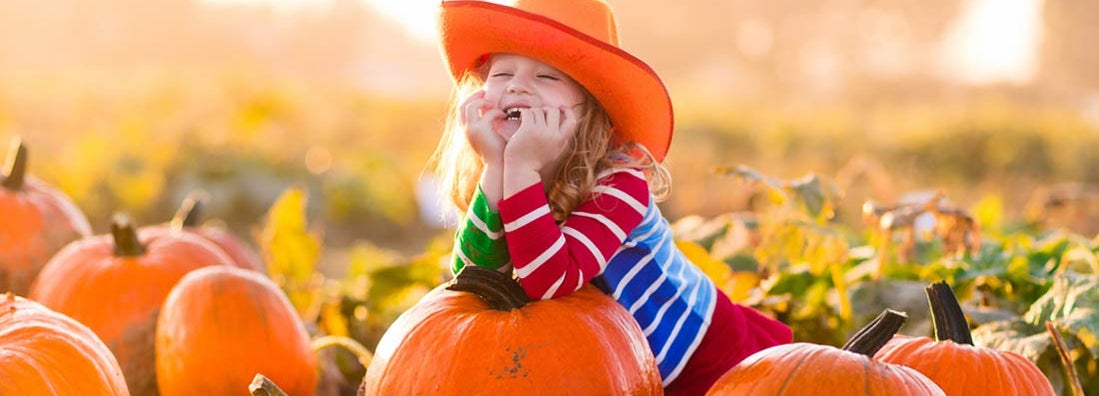Pumpkin Patch Insurance
(Time to find the right prize-winning protection.)

Candace Jenkins is a licensed insurance advisor with over a decade of experience. She is also a writer and loves to write on all things insurance. Candace writes for TrustedChoice.com on a continuous basis and is here with the facts about all your insurance inquiries.

If you are using your Agribusiness as a public pumpkin patch, insurance should be at the top of your list to know about. Insuring your pumpkin patch is a serious matter because you're allowing the public onto your property.
Your independent insurance agent is a knowledgeable resource when it comes to insuring all aspects of your agribusiness farm, including your pumpkin patch. Knowing how coverage works and where to get it is essential in running a business.
How to Insure Your Farm's Pumpkin Patch
Insuring your farm is one thing, but your public pumpkin patch is another. Your pumpkin patch has much more liability due to public risk factors, and as such needs to be carefully and thoughtfully insured.
The best place to start is at the beginning. You'll need to have your independent insurance agent look at pricing and coverages for your pumpkin patch's specifications. So whether you have a small pick-your-own pumpkin patch, or grounds just short of the state fair, your coverage needs to apply adequately.
Your independent insurance agent will need to know the following to get started:
- Your pumpkin patch's specifics: What are the hours of operations, what is your business registered as, what attractions or games will you have on-site, what is each participant charged, what are the gross annual revenues of the pumpkin patch, what year were buildings built and the specifications of each, and what type of equipment and machinery are on the premises?
- What are your buildings, equipment, machinery, farmhouse, and crops worth: This isn't the sentimental value, but what the market can bear and the replacement cost. in other words, what is the value of each individual piece of equipment, building, and crop worth if it were to be replaced?
- What preemptive protection do you have in place: Are there proper protocols to make sure the public stays in open areas and not in restricted parts of the farm, does the pumpkin patch have security cameras, what rules for the public and employees does the pumpkin patch have in place, and how are they being enforced?
When to Insure Your Pumpkin Patch
Well if you already own it, then it's late in the game, so jump on that one quick by contacting your independent insurance agent ASAP. Maybe you own a farm and have everything covered so far, but are now thinking of expanding your pumpkin patch and opening it up to the public. If this is the case, you'll need to change things on your current farm policy because your exposures are quite different.
Once the public gets involved, there is more risk that can occur due to, well, human error. The more humans you have involved, the more things there are that could potentially go wrong. You'll want to chat with your agent on the risks associated and how to be proactive in your journey.
Steps to Take In Minimizing Your Pumpkin Patch Risk
By now you should know that the main purpose of insurance, any insurance, is a transfer of risk. You are essentially transferring your farm's risk to the insurance carrier and paying a monthly, quarterly, or annual premium for the right to tap into their reserves should a claim ever arise.
In order to get the best and lowest premiums, insurance companies like to see that you take your pumpkin patch endeavors seriously. And by that, they want you to be as proactive in your business at minimizing risk as possible. The more risk you avoid, the more risk they avoid and they will reward you by lower premiums.
Some premium-saving, risk-minimizing things to do on your pumpkin patch business:
- Have the public sign waivers absolving you and your pumpkin patch from a lawsuit if they get injured, sick, or otherwise while enjoying the fruits of your labor.
- Have signs posted stating and reminding the public that they are enjoying at their own risk and your pumpkin patch will not be held liable.
- Have employees and farmhand at every station and attraction on the farm to properly train and keep members of the public from harm — a supervisor if you will.
- Hold regular safety meetings for all employees and staff to ensure proper procedures are being adhered to.
- Have clearly marked and sectioned off restricted areas to avoid curiosity seekers.
- Have rules posted, marked, and signed by every attendee to avoid confusion and claims.
- Make sure all children are accompanied by an adult and that rules are posted around that.
- Have all equipment and heavy machinery restricted, disengaged, and put out of harm's way.
Cost of Insuring Your Pumpkin Patch
The answer is, it depends. It's dependent on your pumpkin patch's specifics, like what it's worth and exactly how much coverage you need. Every farmer has different needs, and as such, the pricing will be different. But some price-determining risk factors are good to know.
Pumpkin patch premium determining risk factors:
- Claims: Have you had prior farm claims? If so, your farm policy will most likely put a surcharge on your farm insurance to account for the loss for up to five years.
- Inventory: What does your farm have in stock? How many seeds, crops, livestock, herds, poultry, and so on do you have that would need to be replaced if a major loss occurred? The more you have, the more the premium.
- Equipment and machinery: What pieces of equipment and machinery does your farm have and what are they worth? The more money they cost, you can assume the higher they are to insure.
- Farmhouse: What does your farmhouse look like? Is it old or new? It is big or small? Is it updated with the finest furnishings or does it have a lackluster appeal? The more fancy your farmhouse is, the more it may cost to replace.
- Pole barns and other structures: What is your barn situation? How big is your barn? How many barns do you have? What are they made up of?
- Pumpkin patch specifics: What are your hours of operation? How many attendees do you allow at once on your property? What safety measures are taken? How are employees trained? What is the public allowed to do?
All of these items will determine your pricing and are handy to know off the bat so you can get an accurate quote from your independent insurance agent.
What Does Pumpkin Patch Insurance Cover, and What Does It Not Cover?
When it comes to insuring your farm's pumpkin patch, you should have a pretty good idea of what goes into it. Now you need to know what the policy will actually cover and what it won't.
What your pumpkin patch insurance generally covers:
- Accidents: This can be anything from coverage for fire, smoke, loading, and unloading farm items and more.
- Natural disasters: Volcanic eruption and sinkholes are covered, but typically, floods and earthquakes are covered under a separate policy.
- Weather events: Lightning, wind, hail, tornados, and more are covered. This is where a multiple peril crop insurance that can cover your precious gourds as well as Crop-Hail insurance so you can make sure your prized patch can weather the storms.
- Crimes and civil unrest: This is for theft and vandalism of your pumpkin patch. When you have the public involved, it can happen, so you want to be sure your policy has this coverage.
- Collision or death while transporting: You'll want to be sure your pumpkin patch policy has coverage for hayrides, tractor rides, or whatever moving motored vehicle, machinery, or equipment you may be hauling humans on.
What your pumpkin patch insurance doesn't cover:
- Natural wear and tear of your farm's equipment, buildings, or public-use facilities.
- Items or equipment not working due to wear and tear or general public use.
- Sexual misconduct usually is not an included coverage, but one you may want to have your agent add or take out a separate policy for. Whenever you have children involved, you always want to be sure there is a policy in place for child abuse or any abuse that could occur on your farm's property.
Pumpkin Patch Liability Insurance
If you’re found to be legally responsible for causing bodily injury or property damage to other people or their property as a result of running your pumpkin patch business, you’ll have coverage under the liability portion of your policy. Between that and all the other coverages your farm policy provides, it looks like you'd be in pretty good shape.
Your independent insurance agent can discuss all facets of your farm and pumpkin patch policies making sure you've got the proper coverage in every area.
The Benefits of an Independent Insurance Agent
Independent insurance agents have access to multiple insurance companies, ultimately finding you the best coverage, accessibility, and competitive pricing while working for you. And as your farm grows and your needs change, they'll be there to help you adjust your coverage, up or down, to make sure you're properly protected without overpaying. Find an independent insurance agent in your community here.
https://www.statista.com/statistics/196433/us-farm-income-from-vegetables-since-2001/